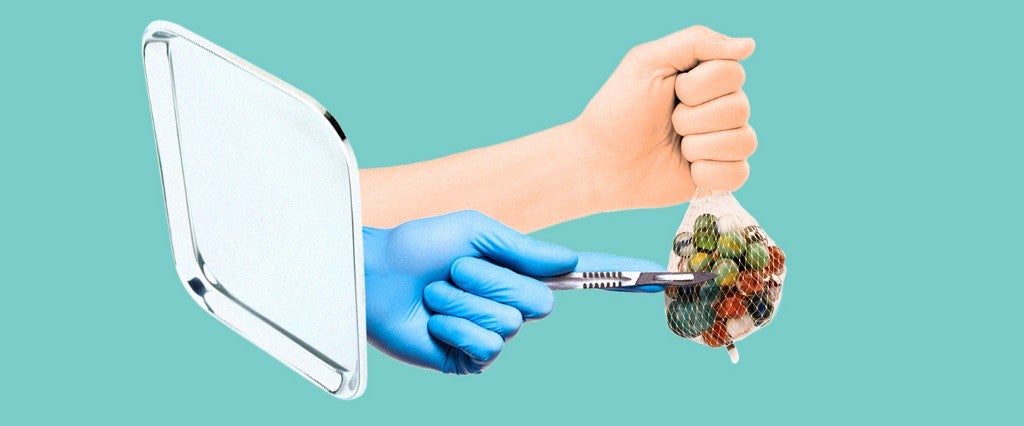Dr. Gary Alter, an assistant clinical professor in plastic surgery at UCLA with practices in Beverly Hills, Manhattan and Dubai, has been performing scrotoplasty, or scrotal lifts, for nearly 20 years. One of just a handful of surgeons who perform the procedure in the U.S., Alter estimates that he performs one scrotoplasty per month. That said, he promises that “if more men knew about the procedure, it would probably be a lot more.”

Many men — both young and old — have scrotums that are large and hang low, so they wish to have some of the skin excised. The skin or the scrotum size irritates them with underwear or sports. Plus, cosmetically, it doesn’t look good.
In extreme cases — and this is generally in much older men — a man’s scrotum is stretched so much it can hit the water in the toilet when they’re sitting down on it. I’ve seen young men who are born with their scrotums hanging low, too, but thanks to gravity, it tends to be much more common as men age.
When the causes for a low-hanging scrotum are congenital, a man may have something called a varicocele. That’s when there’s a bad valve draining the veins in the left testicle. Or better put, it’s not draining blood from the testicle, and instead, the blood builds up, which weighs down the testicle and stretches the scrotum. It also can happen in the right testicle, but less commonly. When I do scrotoplasties on men with varicoceles, I want to make sure that the varicocele has been corrected first because I don’t want the scrotum to stretch again. So generally, men will have that fixed by a urologist prior to our appointment.
Similarly, the scrotum can be large if a man has an excess of clear bodily fluid around the testicle, called a hydrocele; the scrotum will shrink if you eliminate the fluid, but the skin still may have stretched.
As a side note, a lot of these men have what’s called a penile-scrotal web that needs to be corrected. It can be a byproduct of having a low-hanging scrotum, or sometimes it’s caused by a circumcision that removes too much skin. It’s like a turkey neck between the underside of the penis and the scrotum. I’ve also seen a lot of men who just have a web, which is a problem because if it’s too large, you can’t put on a condom all the way, or you might have trouble during penetrative sex. That’s why a lot of times, with the reduction of the scrotum, I’ll do a removal of the web as well.
The surgery itself is outpatient. I do it under general anesthesia, and it usually takes about two hours. The procedure involves removing the skin and sometimes some of the subcutaneous tissue. I have the man in stirrups so I can shape the scrotum, because it’s not just about removing skin, it’s about removing skin and maintaining a natural contour. I put in sutures or staples before I make any incision so I know exactly what I can remove before I remove it. If I’m getting rid of the web at the same time, I give a shot into the penis that opens the arteries and closes the veins, thus causing an erection. This allows me to make sure I don’t take off too much skin.
The number and placement of the incisions depends on the anatomy of the patient. It’s like a breast reduction in that way. It’s also important to try to determine the best location for the scar in order to hide it. Plus, the natural scrotum has different textures and colors in different areas, so you try to bring like with like. If possible, I’ll try to take a crescent shape off the bottom of the scrotum near the perineum, and hide the scar that way. Or I’ll place the incisions either underneath the scrotum or right down the middle on the scrotal and penile raphe, the line that goes down the middle of the scrotum and the penis.
Sometimes I have to do both of these incisions. Other times I have to place the incision horizontally. The art of the surgery is picking the correct pattern that you’re going to use. The incisions are then stitched together at the end of the procedure.
The surgery isn’t very uncomfortable, and my patients go home right afterward. The pain is minimal after the first few days. If there is discomfort, it’s mostly a general discomfort from the skin incision. If they’re in from out-of-town, they stick around for about three days and then they can leave. Generally, I tell them not to have intercourse for five or six weeks after surgery, and no sports for about a month. They can masturbate if it isn’t too traumatic, and they can go back to work a couple of days after the surgery. The stitches themselves dissolve within three to six weeks.
I’m sure men are nervous about the procedure when they come to see me, but they’re usually happy that they’ve found someone who can help with their complaints. Most of them have gone to a urologist who says, “There’s nothing you can do,” or “You’re crazy.” But not me. That was my whole vision when I went into plastic surgery: To fix the problems that make men self-conscious, but are ignored by the medical community.
— As told to Jessica Ogilvie

